In: women
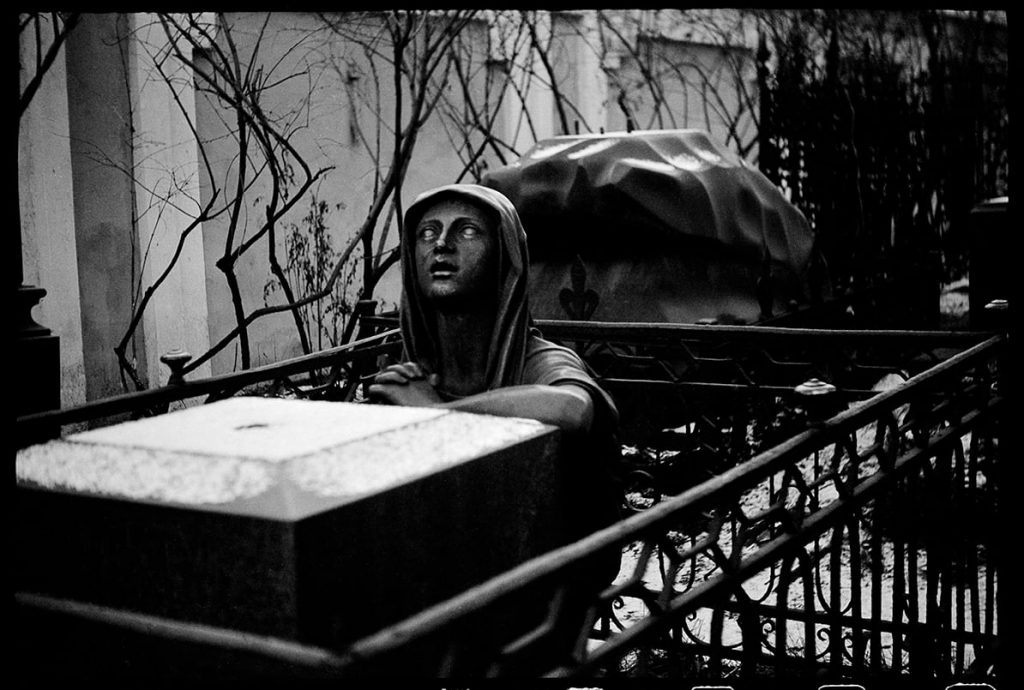
Saint Alexander Nevsky Monastery, Leningrad, USSR | Masha Ivashintsova |1977
July 21, 2023Saint Alexander Nevsky Monastery, Leningrad, USSR | Masha Ivashintsova | 1977
I was not born
to amuse the
Tsars.
— Alexander Pushkin
I loved without memory: is that not an epigraph to the book, which does not exist? I never had a memory for myself, but always for others.
— Masha Ivashintsova
Masha Ivashintsova has been described as a ‘Russian Vivian Maier‘ as she took so many photographs – creating a world, in a way, of her city – in her lifetime but most of them have only been shared since her death. Her eye for contemporary life under the Soviet regime – especially in St. Petersburg later Petrograd later Leningrad then again St. Petersburg (the shift in name and what that entails in the socio political sphere is a good place to stand, when considering Ivashintsova’s photographs) – was an honest and personal portrait of her life and times. One might argue that the veracity of these experiences captured with her lens were – are – so honest and powerful that we can understand why she held them to herself for so long. Her own personal history was also painful, and that was surely a factor, too.
Or, perhaps as I allude to with the quote from Pushkin, autocratic, authoritarian societies prefer facile propaganda and punish uncomfortable truths….
Ivashintsova (1942 − 2000) was a photographer based in Saint – Petersburg (then Leningrad, in the USSR) “who was heavily engaged in the Leningrad poetic and photography underground movement of the 1960−80s. Masha photographed prolifically throughout most of her life, but she hoarded her photo-films in the attic and rarely developed them. Only when her daughter Asya found some 30,000 negatives in their attic in 2017 did Masha’s works become public.”(from here)
“Struggling with life under Communism, by the mid-1980s Masha was committed to a mental hospital against her will, as a way to get her in line with the USSR’s philosophies. Working throughout her life as a theater critic, librarian, cloakroom attendant, design engineer, elevator mechanic, and security guard/riflewoman, she was a chameleon, always camouflaging her inner artist. Only through her diaries and photographs was she able to show her true self.”
A fine article – and interview – with her daughter Asya Ivashintsova-Melkumyan can be enjoyed here. A site devoted to Ivashintsova’s amazing archive can be seen here : as well, there is a social media page that shares her work at regular intervals here.
~ Bart Gazzola
Read More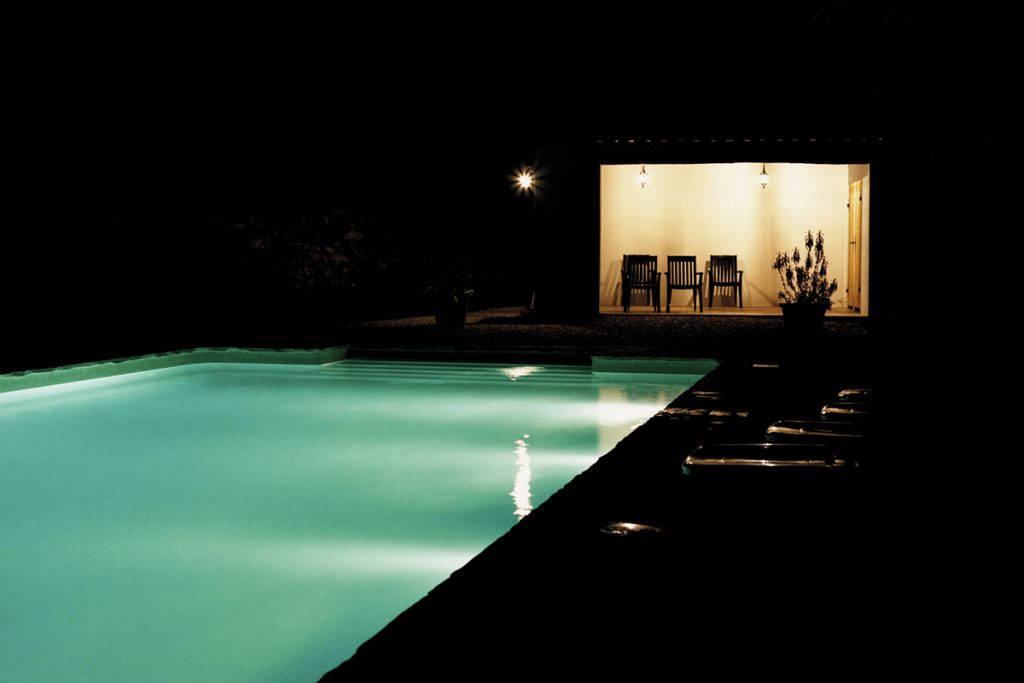
Alys Tomlinson | Dead Time | 2004 – 2006
June 23, 2023Alys Tomlinson | Dead Time | 2004 – 2006
“I like to remember things my own way.”
“What do you mean by that?”
“How I remember them. Not necessarily the way they happened.”
(from Lost Highway)
I’ve recently begun rewatching the third season of Twin Peaks (I mention this as Alys Tomlinson has spoken of Dead Time with allusions to the painter Edward Hopper but also that ephemeral notion of the Lynchian landscape): there’s a scene where Shawn Colvin’s version of Viva Las Vegas is a soft and enchanting soundtrack to the unfolding scene, and I happened to be listening to that song as I was perusing Tomlinson’s Dead Time series online. Vegas is, they say, a place where time is fluid, or can be lost or doesn’t exist in the same manner as elsewhere….
Tomlinson’s scenes are more Lynch’s Mulholland Drive or Lost Highway than Twin Peaks, with harsh artificial light casting edged shadows and revealing a sinister tableaux. Some critics have spoken of how time in the Lynchian universe – especially in Twin Peaks – is non linear, and Tomlinson’s images have an eerie familiarity (I’ve also travelled long distances by car and spent evenings in motels that, in recollection, blur together into one continuous banal experience).
There’s an element of the same unsettling darkness and emptiness that Steve Laurie employs in some of his images that also invite us to see them as film stills and create our own narratives for them. Tomlinson’s ‘America’ is empty, hard and bright. Swimming pools – usually sites of social interaction and enjoyment – are harbingers that seem more nefarious, here.
“For the past few years Alys has been photographing empty swimming pools at night in the UK and abroad. The images explore a twilight world of the in-between: a blurring of day and night, light and dark, the open and the enclosed, plenitude and absence. Whether municipal or members only, the pool is a space shaped by its patrons. Captured out of use, these familiar spaces stand outside time. Curved light breaks up the horizontal rigour. The comfort of transparency gives way to reflection and shadow. What is cedes to what could be, and the ordinary is transformed. The geographical location of each swimming pool is kept secret. Shot at dusk or at night, the pools take on a detached, almost melancholy, emptiness, and suggest a sinister feeling that something has happened, or is about to happen.” (from here)
Alys Tomlinson’s site can be seen here (she’s an award winning photographer and the diversity of her work speaks to her acumen with a lens, both formally and conceptually) and her IG is here. She has produced a book of these images, as well.
~ Bart Gazzola
Read More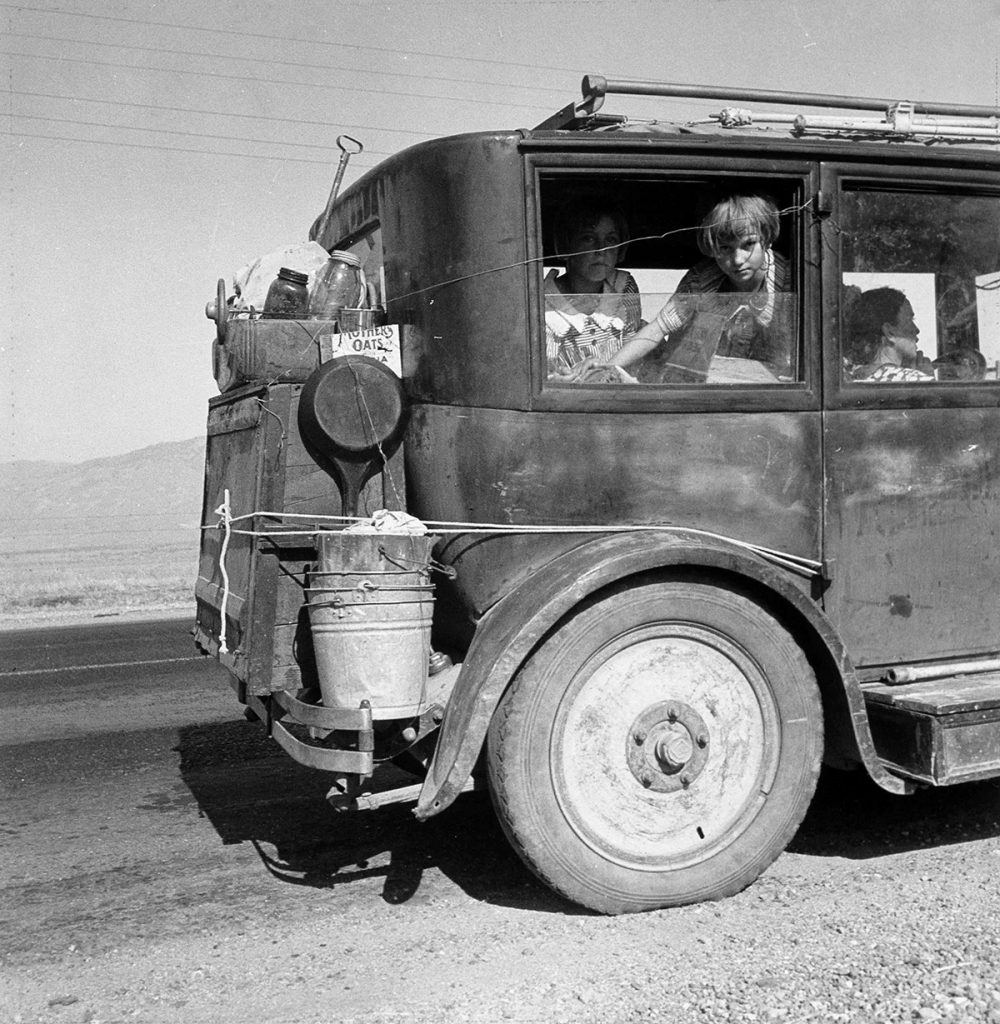
Dorothea Lange | A family of drought refugees from Abilene, Texas, on the road in California | 1936
May 4, 2023Dorothea Lange (1895 – 1965) | A family of drought refugees from Abilene, Texas, on the road in California | 1936
“The depression was making people disappear.
They vanished from factories and warehouses and workshops, the number of toilers halving, then halving again, until finally all were gone, the doors closed and padlocked, the buildings like tombs. They vanished from the lunchtime spots where they used to congregate, the diners and deli counters where they would grab coffee on the way in or a slice of pie on the way out.
They disappeared from the streets.
They were whisked from the apartments whose rents they couldn’t meet and carted out of the homes whose mortgages they couldn’t keep pace with, lending once thriving neighborhoods a desolate air, broken windows on porches and trash strewn across overgrown yards. They disappeared from the buses and streetcars, choosing to wear out their shoe leather rather than drop another dime down the driver’s metal bucket. They disappeared from shops and markets, because if you yourself could spend a few hours to build it, sew it, repair it, reline it, reshod it, reclod it, or reinvent it for some other purpose, you sure as hell weren’t going to buy a new one.
They disappeared from bedrooms, seeking solace where they could: a speakeasy, or, once the mistake of Prohibition had been corrected, a reopened tavern, or another woman’s arms—someone who might not have known their name and certainly didn’t know their faults well enough to judge them, someone who needed a laugh as badly as they did.
They disappeared, but never before your eyes; they never had that magic. It was like a shadow when the sun has set; you don’t notice the shadow’s absence because you expect it. But the next morning the sun rises, and the shadow’s still gone.”
(Thomas Mullen, The Many Deaths of the Firefly Brothers)
I have a tendency in my research to fall down rabbit holes: this is often shaped by history (my interest – which has manifested on this site – in post Soviet artists, for example) and of late The Great Depression has been a point of interest. My enjoyment of horror intersects here, so I will confess that I came to the author that I quote liberally above (whose book follows two brothers whom are bank robbers during the Great Depression, harshly factual and researched, but they find they are resurrected each time they’re killed in one of their robberies) through Daniel Knauf’s Carnivàle series. But, like another writer has pointed out, improbability and violence overflow from ordinary life, and the Great Depression was a time more, perhaps, malleable than most, as many assumptions were fractured irreparably…
And the horrors experienced by many from the Crash of 1929 through the Depression were ‘unimaginable’ to many, until they became commonplace, and now, it seems, have been forgotten. This is similar to how we forget that Lange’s subjects are not just icons but actual people who lived, suffered and died.
To many, Lange’s work requires no introduction. Many of her photographs are so stitched into the fabric of a communal history that they act as signifiers for collective memories. Nonetheless: Dorothea Lange “was an American documentary photographer and photojournalist, best known for her Depression-era work for the Farm Security Administration (FSA). Lange’s photographs influenced the development of documentary photography and humanized the consequences of the Great Depression.” (from here)
I return to Mullen’s book that had flavours of horror, but not in the way I expected, as it was more historical than ‘supernatural’ horror:
“Ten feet behind them, standing at the base of an arc light and looking in the opposite direction, was a young, balding man who Weston supposed was the father. The man looked as if he were trying very hard to become invisible.
When you bump into an old acquaintance on the street, you ask him how he’s doing. He tells you a story and then you tell him your story, and both of you are trying to see where you fit within the other’s. Your story says: This is the way the world is, and I’m the center, over here. But if the other guy tells a different story, with the world like this, where the center’s actually over here, then you realize that you’re way off to the side.
This man did not need to be told he was off to the side. He clearly realized it.”
More of Lange’s work – both her iconic images of The Great Depression and her later work that was more local but considered the same issues of justice and equality – can be seen here.
~ Bart Gazzola
Read More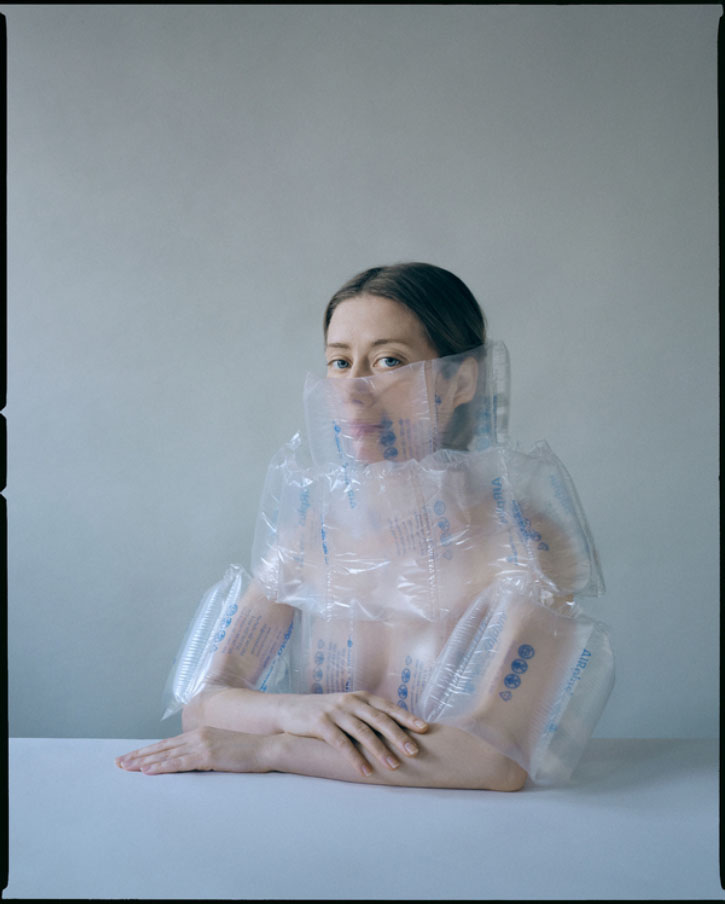
Kristina Varaksina | Self portrait wrapped, 2020
April 27, 2023Kristina Varaksina | Self portrait wrapped, from the Self Reflection series, 2020
“Why do men feel threatened by women?” I asked a male friend of mine. (I love that wonderful rhetorical device, “a male friend of mine.” It’s often used by female journalists when they want to say something particularly bitchy but don’t want to be held responsible for it themselves. It also lets people know that you do have male friends, that you aren’t one of those fire-breathing mythical monsters, The Radical Feminists, who walk around with little pairs of scissors and kick men in the shins if they open doors for you. “A male friend of mine” also gives — let us admit it — a certain weight to the opinions expressed.)
So this male friend of mine, who does by the way exist, conveniently entered into the following dialogue. “I mean,” I said, “men are bigger, most of the time, they can run faster, strangle better, and they have on the average a lot more money and power.” “They’re afraid women will laugh at them,” he said. “Undercut their world view.”
Then I asked some women students in a quickie poetry seminar I was giving, “Why do women feel threatened by men?” “They’re afraid of being killed,” they said.
(Margaret Atwood, Second Words: Selected Critical Prose, 1982)
Kristina Varaksina received her Master’s in Photography from the Academy of Art University, San Francisco, in 2013. Born in Russia, Varaksina has resided in the USA since 2010 and currently divides her time between London and New York.
From here: “In her personal work, Varaksina explores the vulnerabilities, insecurities and self-search of a woman and an artist. Her work is a creative response to what’s going on in the world and her immediate environment. Through visual symbolism, carefully curated colour palettes and cinematic lighting she reflects the strongest emotions she and her subjects experience.” I would inject another line from Atwood here, in response: I’m working on my own life story. I don’t mean I’m putting it together; no, I’m taking it apart.
Varaksina gives voice to women from different ethnic, socio-economic, and cultural backgrounds, each doing their best to accept themselves as who they are and be proud of that. Varaksina sees her job as a photographer to make “ordinary” women more visible and therefore, more valuable.”
Varaksina has earned numerous awards for her work: her figures alternate between an unflinching gaze that challenges – perhaps unnerves – the viewer, and a stillness where our presence is neither requested or needed, intruding into the quiet being of her subjects. The Self Reflection series – which is ongoing – has been described as both ‘claustrophobic’ and a commentary on the history of portraiture in the Western canon. In this body of work, her stare is direct and unrelenting, as she not only turns her camera on herself as part of her work about women but turns her gaze upon us, too.
More of her work can be seen here. Varaksina’s IG is @kristinavaraksina
~ Bart Gazzola
Read More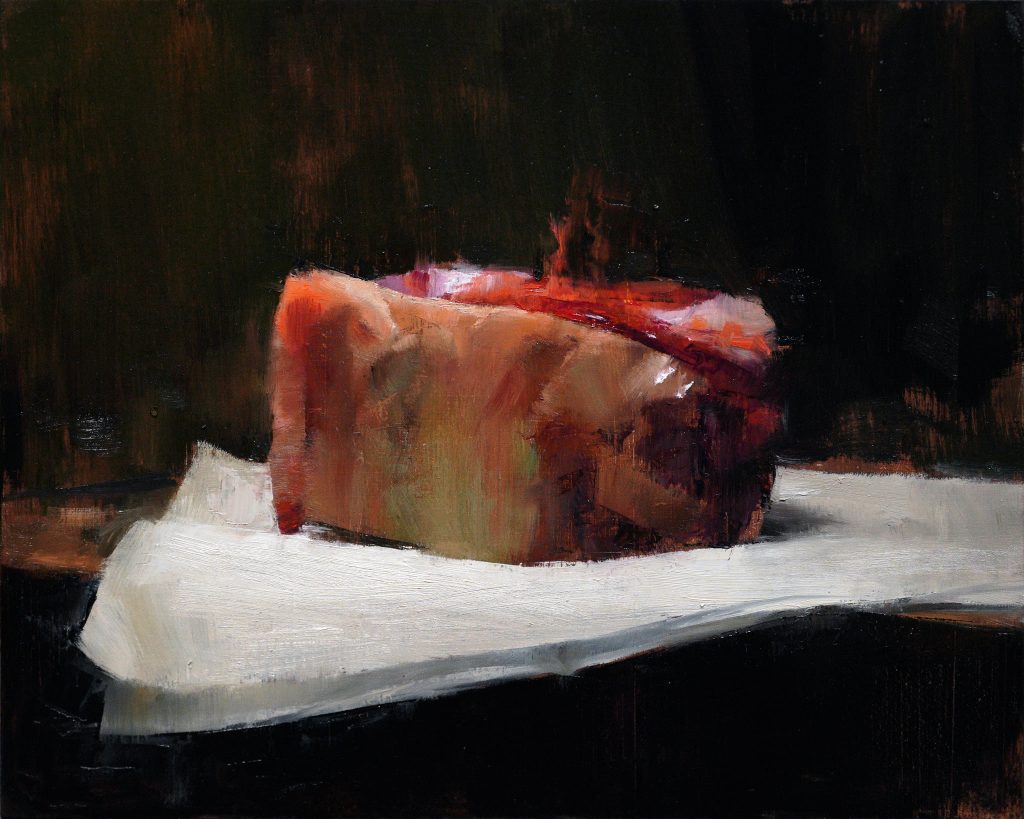
Scott Conary | Lamb on Paper, 2023
April 20, 2023Scott Conary | Lamb on Paper, 2023
Flesh is our indisputable commonality. Whatever our race, our religion, our politics we are faced every morning with the fact of our bodies. Their frailties, their demands, their desires. And yet the erotic appetites that spring from – and are expressed through – those bodies, are so often a source of bitter dissension and division. Acts that offer a glimpse of transcendence to one group are condemned by another. We are pressured from every side – by peers, by church, by state – to accept the consensual definition of taboo; though so often what excites our imaginations most is the violation of taboo. (Clive Barker)
Meat, weeds, eggs, bottles, and bones. What began as a way to get back to the basics of painting, without an agenda, became something else. The meat paintings are, understandably, the pieces that elicit the most questions. The first is usually, “Why meat?” The glib answer is “you can only paint so many pears.” The longer answer is that the meat is beautiful and somewhat evocative. We have a much more complicated reaction to a hunk of lamb than we do to pepper. The meat is the stuff of us. We are, after all, meat. The smell shifts while I work. The color changes. I have vivid memories of meals with family and friends built around meat. It’s beautiful, desirable, and it’s unclean. (Scott Conary)
At a very young age I encountered Alina Reyes’ novel Le Boucher [The Butcher] : consider that your only warning, before you proceed.
Let us talk about meat, about the way of all flesh, about the grotesque and evocative history of painters and photographers offering us a sense of the sensual and the shocking.
Ah, but before we get to that I must say that when I encountered Scott Conary’s work on one of my social media feeds, I was struck by it’s beauty and execution (I was unsurprised it’s painted in oils, as there’s a sensuality to that medium) and it sent me on a deeper exploration of his works.
His words also acknowledge that this choice of subject matter is neither new nor to be eschewed. Many artists have employed this trope to investigate or confront larger issues: Chaïm Soutine’s Carcass of Beef, or Rembrandt van Rijn’s Slaughtered Ox, function both as still lives – though I might use the French term of nature morte, here – but also as metaphors, whether for religion, suffering, violence or our own ongoing obsession and repulsion with our own physicality.
Conary’s renderings of meat and flesh – like many of the artists whose works I’ve shared in this post – are inappropriately beautiful.
But that beauty is tendered by how it is often metaphor, as well. One of the works I share below by Ilya Mashkov, considering the date of its execution during the Russian Civil War, is a commentary that evokes the words of his contemporary, Boris Pasternak, where his character Zhivago, speaking to the local commissar (after examining a dying man) sardonically avers that “It isn’t typhus. It’s another disease we don’t have in Moscow…starvation.” Andres Serrano‘s Cabeza de Vaca references a Spanish ‘explorer’, presented as plunder instead of plunderer, and Mark Ryden’s Meat Dress offers something for us to visually consume that explores some of the same ideas as Jana Sterbak’s Vanitas: Flesh Dress for an Albino Anorectic (which I’ve written about before) but in a more palatable form, perhaps.
Two more artists to share, that expand the conversation around Scott Conary’s meat works (I want to type that as one word – meatworks – as that seems more viscerally appropriate): Victoria Reynolds‘ art also offers “an uneasy tension between the understanding of flesh as food, and our self-identification of it; her conflation of desire, mortality, viscerality, and the survival instinct is a powerful source of aesthetic fascination.” Kanevsky, on the other hand, is primarily a figurative artist, as an American with heavy Eastern European influences. When you look at more of his work, and his preference for nudes, you may be forgiven for thinking that the work below is just painting the interior, instead of the exterior, of his ‘models’….
More of Scott Conary’s work can be seen here and his IG can be found here. His practice – and choice of subject matter – is quite varied (I was simply seduced by his meat works, if you will, but I did consider using his interpretations of eggs as a basis for a curator’s pick, as well) and worth exploring.
~ Bart Gazzola
Read More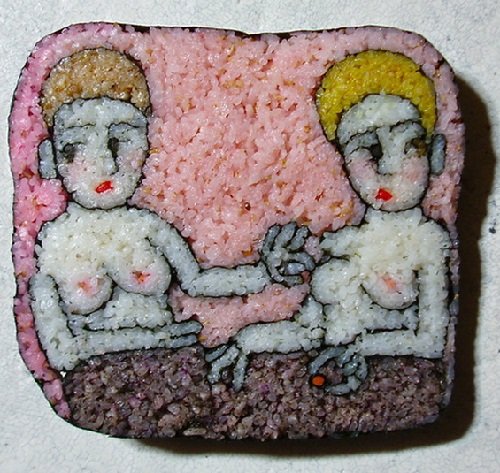
Takayo Kiyota | Tama-Chan
April 6, 2023Takayo Kiyota | Tama-Chan
“That’s what you get for being food.”
― Margaret Atwood, The Edible Woman
Takayo Kiyota (also known as Tama-Chan) produces what can only be described as sushi art: some are playful, some are slightly more unsettling and others offer an interesting opportunity for dialogue about our relationship to food and larger assumptions around aesthetics.
In this artwork, Kiyota – who has interpreted famous works such as Edvard Munch’s The Scream (1893) or Vermeer’s Girl With A Pearl Earring | Meisje met de parel (1665) – re-imagines a painting that is well known but often misconstrued, sometimes in a bawdy manner.
Gabrielle d’Estrées et une de ses soeurs (Gabrielle d’Estrées and one of her sisters) was painted by an unknown artist (perhaps from the Fountainbleau School) around 1594. It can seen in the Louvre, in Paris: “The painting portrays Gabrielle d’Estrées, mistress of King Henry IV of France, sitting nude in a bath, holding a ring. Her sister Julienne-Hyppolite-Joséphine sits nude beside her and pinches d’Estrées’ right nipple.” More about this painting can be seen here.
Years ago, I experienced an audio environment / installation by Anitra Hamilton: the bare gallery space was inundated by two conflicting yet connected audible narratives. One section of the gallery was suffused by a recording of a Sotheby’s auction of artworks. The other was a cattle auction, with ‘prize’ animals going to the highest bidder. In a response to that exhibition I made some uncomfortable analogies to what we consume, how we value it, and the conversations around these things that ‘feed’ us.
Tama-chan (Takayo Kiyota) was born in Shinjuku, Tokyo. After graduating from the Setsu Mode Seminar she started to work in advertisement, magazines, and books as a freelance illustrator. Since 2005, she has called herself the sushi roll artist “Tama-chan.” Through workshops she has been introducing the importance of food culture, food education, as well as the joy of making things with her maki-sushi. In 2013, she won the second prize on “the longest scream in the world” sponsored by Innovation Norway. In 2014, Little More Co. published Smiling Sushi Roll, the first anthology of her work.
You can see more of these delicate and temporary artworks on IG : @smilingsushiroll39
~ Bart Gazzola
Read More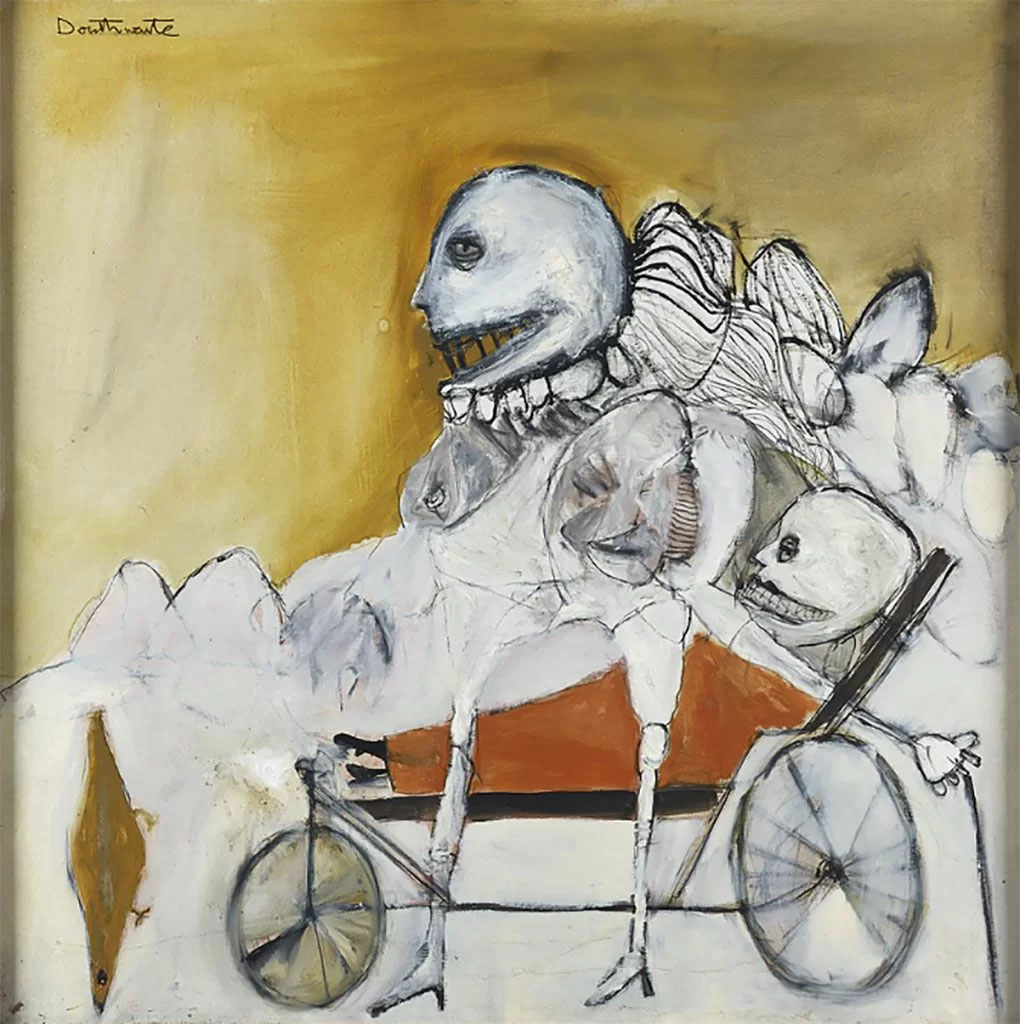
Pat Douthwaite | Bernard Berenson at Leptis Magna, 1966
March 31, 2023Pat Douthwaite | Bernard Berenson at Leptis Magna, 1966
I am only a picture-taster, the way others are wine – or tea – tasters.
Bernard Berenson
Years ago when I was on a panel talking about ‘modernism’ I offered a line from Clement Greenberg, that is one of my favourites (not solely for the idea expressed, but also as it seemed to fly in the face of many of the karaoke modernists who attended that discussion on the prairies who are sure ‘art’ ended with hard edged painting several decades ago): that we evaluate artwork with the criteria we have now, but fully understanding that this criteria can and must change.
Greenberg is one of the ‘old gods’ of the Western art canon – like Bernard Berenson, the erstwhile subject of this painting by Douthwaite. The site that Berenson is ‘visiting’ in this painting is of significant archeological important (more on that can be read here). Berenson (1865 – 1959) was an American art historian specializing in the Renaissance, but his influence was much more than that, and he is one of the shoals of Western art history that is to be negotiated.
But – in deference to contested narratives, and considering how Douthwaite has, like too many female artists, not garnered the acclaim of some of her male colleagues – I also offer Atwood’s iconic line: “We were the people who were not in the papers. We lived in the blank white spaces at the edges of print. It gave us more freedom. We lived in the gaps between the stories.” Douthwaite’s paintings have a striking originality, and though she’s often compared to Chaïm Soutine he is also – like Douthwaite – an artist whose work is immediately recognizable. This painting has a carnivalesque quality to it, and the ‘skulls’ suggest a merry dance of death…. she often “referred to herself as the “high priestess of the grotesque”, aptly describing her dedication to the arresting, often haunting, figurative work that carved out her place within British postwar art…[Douthwaite] was a distinctive and complex artist rather than [simply] a “difficult” woman, as she was sometimes described.” (from here)
Douthwaite’s approach is unique: ‘Instead of the traditional easel set up, Douthwaite preferred to paint on the floor: ‘I crawl around the floor on my knees, with a butcher’s apron round me, moving from drawing to drawing or canvas to canvas.’ She was unconventional in her painting technique too and rather than use brushes she worked the images up from the surface of the canvas using paint-soaked rags. She often depicts death with humour as if to underline the absurdity of life.’ (from here)
Pat Douthwaite was born in Glasgow in 1939 and initially studied mime and modern dance with Margaret Morris. She is primarily self taught, though in 1958 Pat lived in Suffolk with a group of painters. From 1959 to 1988 she travelled widely (North Africa, India, Peru, Venezuela, Europe, USA, Kashmir, Nepal, Pakistan, Ecuador) and from 1969 lived part of the time in Majorca. Douthwaite exhibited with the Women’s International Art Club in London between 1960 and 1966. She returned to spend the rest of her life in Scotland, passing away in 2002 at Dundee. In 2005 the Scottish National Gallery in Edinburgh mounted a memorial exhibition to mark her life and work.
Much more of her work can be seen here, and more about her life can be learned here.
~ Bart Gazzola
Read More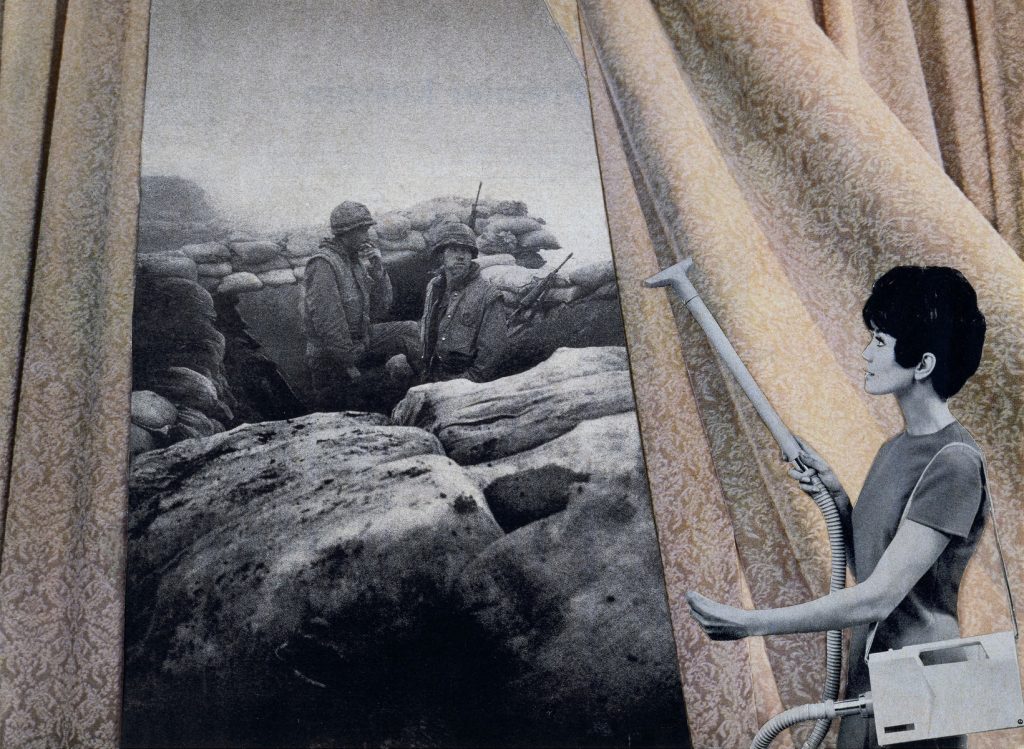
Martha Rosler | House Beautiful: Bringing the War Home, 1967–1972
March 24, 2023Martha Rosler | House Beautiful: Bringing the War Home, 1967–1972
Cotton’s generation grew up with a war in the house. For them, games of cops and robbers and cowboys and Indians no longer satisfied the senses. A boy had but to turn a control to be totally involved in the violent distension of experience that was Vietnam on television. Cotton became addicted to it. Vietnam was even a portable war.
A boy had but to move his personal set to have air strikes in the living room, search-and-destroy operations in the bedroom, naval bombardment in the bathroom—napalm before school, body bags before dinner.
(Glendon Swarthout, Bless the Beasts and the Children)
I recently read The Sacred Lies of Minnow Bly by Stephanie Oakes. The premise – of a young woman who survives a doomsday cult – sent me down a rabbit hole, if you will, of research on these cults, and since then I’ve been devouring a number of texts on the topic.
One of these – Jeffrey Melnick, Charles Manson’s Creepy Crawl: The Many Lives of America’s Most Infamous Family – offers an interesting supposition. Melnick argues that the Tate – LaBianca murders were used by many on the right – Nixon, for example – as a means by which to shutter debate about the (even then) failure of the nuclear family in the United States. This is similar to Zizek’s comment that most conversations about socialism always have a chicken little proclaiming it ‘will end in the gulag!’. Other societal issues are cast in a different light from the Manson murders, as well (for example, Melnick talks about the dismissive attitude towards runaways – especially girls – at that time, criminalizing or infantilizing them, using several of the Manson ‘family’ as examples, instead of focusing on larger issues within society).
Melnick dismisses with derision the idea that Manson ‘ended’ the supposed utopic dream of the 1960s – and for this post, a point he makes stays with me. Bluntly, that the violence of the Manson family was nary a drop in the bucket to the televised, sanctioned and officially endorsed violence of the war in Vietnam and other societal pressures. His words: “If the countercultural fabric got torn it was not because a few celebrities were killed in August of 1969. We would be better off attending to the plight of returning veterans, the not unconnected influx of harder drugs into American cities, the ongoing runaway crisis, and a major effort by the dominant culture—from the president on down—to repudiate and abandon young people and their culture.”
And this brings us to Martha Rosler’s series House Beautiful: Bringing the War Home, 1967–72.
The initial incarnation of this series was about Vietnam: in a despairing commentary about history Rosler would revisit and reinterpret it decades later, for the ‘war against terror’ in Iraq and Afghanistan…..
Rosler – in the tradition of artists like Hannah Höch – employs collage, using images that are familiar to us in tandem with others that fracture and trouble the original ‘homes’ on display. These might ‘homes’ in the literal sense, but also the ideologies and assumptions that inform those spaces, sometimes so implicitly that to highlight them engenders a denial of them, like a fish unaware of water as it’s so ubiquitous.
‘This work is one of twenty pieces from Rosler’s House Beautiful: Bringing the War Home (c.1967-72) series created during, and influenced by, the Vietnam War. It was the first war in history that was literally brought into the homes of American people through the revolutionary new television set from which its horrors could be witnessed daily. It was often described as a “living room war” – a description loaded with strange poignancy as it shined a light on the eeriness of a nation living their everyday lives, ripe with consumerist concerns like keeping the stylish home drapes clean, all the while gruesome political realities took place elsewhere, becoming just another form of nightly entertainment in front of the tube.
Simultaneously, there is a feminist element to the work as it comments on the robotic mundaneness of female domestic work in the midst of global unrest. The idea of women striving to keep the house beautiful while war’s tragedies are omnipresent becomes almost comical, and presents a surreal picture about what we deem important. Recognizing the potential for manipulation in the photographic medium, Rosler once stated, “Any familiarity with photographic history shows that manipulation is integral to photography.”’ (from here)
More of Rosler’s extensive practice – and her roles as social critic and historian for more than half a century – can be seen here.
~ Bart Gazzola
Read More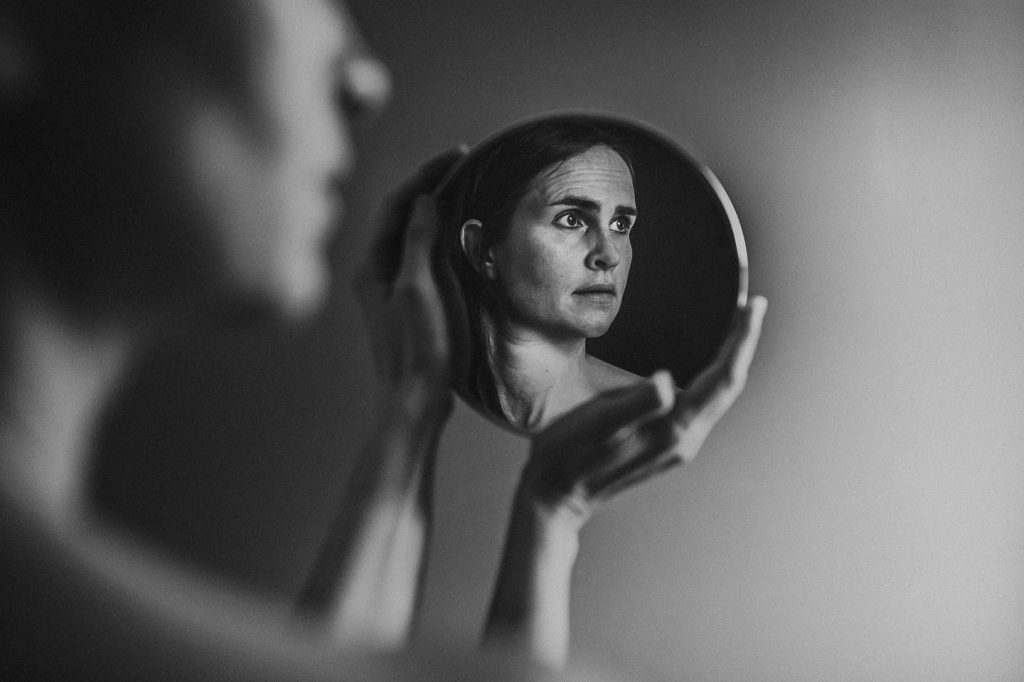
Robin Claire Fox | Reflections
March 17, 2023Robin Claire Fox | Reflections
Photography is inherently nostalgic. Every image taken is essentially the capturing of a moment from the past. That moment no longer exists, just the memory of it and an analogue print or a digital impression trapped on an electronic device. Many modern photographers harbour longings for the saturated or contrasty renderings of images made with processes and media (like Kodachrome) long out of use or no longer in production. Quite a few of them try to recreate the look and feel of these processes digitally, running their captures through filters and algorithms to bring back the visual past. While many are overdone (why keep it at 3 when you can dial it up to 10?), there are a few who have mastered the ability to make us believe that we are viewing an image taken decades ago. The evocation of this photographic past is (I believe) an effort to physically reconnect with it in a way that seems familiar, safe and warm… like sitting with your family watching slides projections of photos from a vacation taken years ago.
Ancaster, Ontario’s Robin Fox started taking photographs around the time of the birth of her most recent child as a conscious attempt to document her family’s childhoods for her future self to enjoy. She is a natural at capturing the uncertainties alongside the joys of growing up. A huge fan of Saul Leiter’s colour work, she has found a method of perfectly capturing the deep saturation and contrast Leiter exhibited in his work with Kodachrome and other slide films[1] in the 1950’s. Her images seem imbued with palettes that exist only in the memory of childhood, where everything was so much bigger and the world was awash with primary colours.
Read More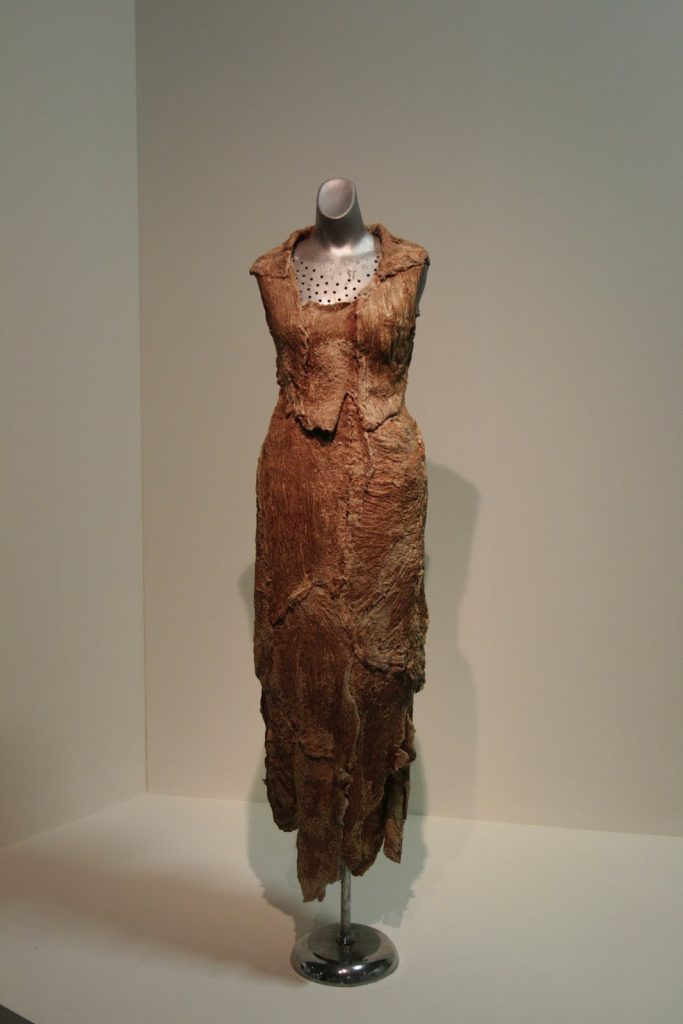
Jana Sterbak | Vanitas: Flesh Dress for an Albino Anorectic, 1987
March 16, 2023Jana Sterbak | Vanitas: Flesh Dress for an Albino Anorectic, 1987
“Adam was left alone. It was then that God created the Second Wife.”
“Yeah? What was her name?”
“Oh. She never had a name, poor thing. God created her for Adam, out of nothingness. Bones first. Then internal organs. Then flesh. Muscle. Sinew. Fat. Bile. Eyes. Snot. Skin. Hair. Breath…
Adam couldn’t bear to go near her. He wouldn’t touch her.
Bodies are strange. Some people have real problems with the stuff that goes on inside them.”
“Jesus. What happened to her?”
“Opinions differ. Most say God destroyed her. A few have claimed that she was permitted to leave the Garden alone.”
(Neil Gaiman, A Parliament of Rooks)
Ah, the controversy, the pearl clutching, the performative gnashing of teeth: back when this work was installed at the National Gallery of Canada, you would have thought that a Canadian government had wilfully allowed a citizen to be tortured or sent body bags to an Indigenous Reserve as a continuing pattern of colonial violence both literal and ideological. To inject my own time in Saskatchewan, it’s not like Premier who has three DUIs where one led to the death of a young mother, or like Indigenous men are being dumped outside the city, in winter, by police.
In tandem with the hypocrisy around the purchase of Barnett Newman’s Voice of Fire (which has only appreciated with age, unlike the money the taxpayers have paid out in unmerited pensions and perks to the ‘politicians’ who whined about it), it was a strange time for the visual arts in Canada.
But now some facts to balance that vitriolic tangent.
“The artwork consists of a “Flesh Dress”, constructed of slabs of beef sewn together, hung on a tailor’s dummy. It is a one-piece, sleeveless, calf-length “house dress”, with a jagged edge. The marble texture of steak and the thick fat are fully visible, displaying its expressive and bloody appearance. On a nearby wall, a photograph of a young woman poses in the dress. The dress is stitched together from 50–60 pounds of raw flank steak and must be constructed anew each time it is shown. Initially, the steak is fresh and fiery red, and then it gradually turned beige and brown, changing its shape and size to conform to the dummy’s hourglass shape. The work included either $260 or $300 worth of meat, as of its 1991 showing.
As suggested by the title, the work is considered within the genre of “vanitas”, a category of art showing death and decay. The work includes non-traditional materials, a trend in 20th-century art. It “stands in the Surrealist tradition of the uncanny….disturbing the distinctions, by which we categorize experience”.
Progressive Conservative MP Felix Holtmann, a pig farmer from Manitoba commented: “I call it a jerky dress. There are a lot of people who hold food sacred in this land, and they are appalled by the use of food for this thing.” In response, one newspaper editorial called him a “meat head”. Holtmann was chair of the House of Commons Communications and Culture Committee, which oversees the NGC funding; the committee itself was split on the issue. The artist called Holtmann a “self-proclaimed Philistine [who is] not even successful as a hog farmer.” Art critic Christopher Hume commented that the committee’s concept “was based on the notion that the National Gallery is somehow accountable for poverty and hunger in Canada. Surely the irony of their desperate position is that they are members of the group that created the mess the country is now in.””
(All of the above from here).
Sarah Milroy – then writing for Canadian Art, now one of the engines driving the Art Canada Institute – observed that reaction would have been very different if the artist had been male. I’d also inject an observation from Lucy Lippard, when she was writing about the controversies in the United States around the works of Andres Serano, Karen Finley and Robert Mapplethorpe: most – if not all – were driven by those defined – or deformed, if you will – by religion, and thus the body is always ‘bad’ and the only thing worse than that is a woman who makes work about the body. How little has changed, it seems.
But the work itself is at that intersection of horror and aesthetic evocation that we know from art history in the works of Francis Bacon or Francisco Goya. In other ways, this installation by Sterbak can be considered in tandem with Carolyn Wren’s War Map Dress Trilogy, that is a more subtle assertion of Barbara Kruger’s iconic work Untitled (Your body is a battleground).
I feel it’s also important to disclose that while writing this, I was also rewatching Todd Haynes film Superstar: The Karen Carpenter Story that “portrays the last 17 years of singer Karen Carpenter’s life, as she struggled with anorexia.” (from here) This is also an artwork that had to deal with the travails of censorship…..
About the artist: “Jana Sterbak forges conceptual, architectonic objects that encourage their wearers to experience bodily and out-of-body freedom. Drawn to notions of doubling, physicality, and self-awareness, she favors juxtapositions between vanity and decomposition as a reminder of human vulnerability. This is evident in her dress of raw meat, which is meant to rest on a hanger until it rots and deteriorates. Such wearable, cage-like constructions allude to technological and societal constraints and a quest for freedom beyond corporeality. Sterbak’s art is marked by a dark humor and absurdist themes likely influenced by her childhood in Prague and education under Marxist and Leninist systems as well as the work of such writers as Franz Kafka and Jaroslav Hasek.” (from here)
More about Sterbak’s life and work can be seen here.
~ Bart Gazzola
Read More
Recent Comments